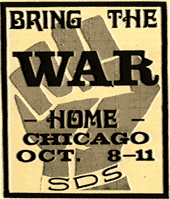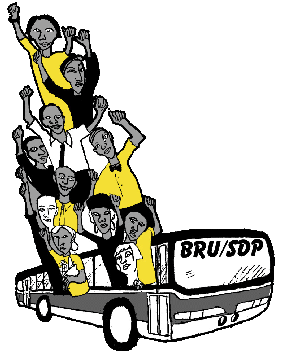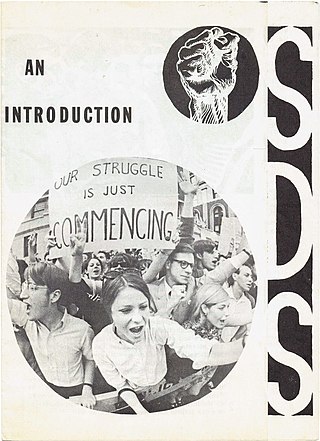Related Research Articles

The Weather Underground was a far-left Marxist militant organization first active in 1969, founded on the Ann Arbor campus of the University of Michigan. Originally known as the Weathermen, the group was organized as a faction of Students for a Democratic Society (SDS) national leadership. Officially known as the Weather Underground Organization (WUO) beginning in 1970, the group's express political goal was to create a revolutionary party to overthrow the United States government, which WUO believed to be imperialist.

The civil rights movement was a social movement and campaign from 1954 to 1968 in the United States to abolish legalized racial segregation, discrimination, and disenfranchisement in the country. The movement had its origins in the Reconstruction era during the late 19th century and had its modern roots in the 1940s, although the movement made its largest legislative gains in the 1960s after years of direct actions and grassroots protests. The social movement's major nonviolent resistance and civil disobedience campaigns eventually secured new protections in federal law for the civil rights of all Americans.

The Student Nonviolent Coordinating Committee was the principal channel of student commitment in the United States to the civil rights movement during the 1960s. Emerging in 1960 from the student-led sit-ins at segregated lunch counters in Greensboro, North Carolina, and Nashville, Tennessee, the Committee sought to coordinate and assist direct-action challenges to the civic segregation and political exclusion of African Americans. From 1962, with the support of the Voter Education Project, SNCC committed to the registration and mobilization of black voters in the Deep South. Affiliates such as the Mississippi Freedom Democratic Party and the Lowndes County Freedom Organization in Alabama also worked to increase the pressure on federal and state government to enforce constitutional protections.

The Congress of Racial Equality (CORE) is an African-American civil rights organization in the United States that played a pivotal role for African Americans in the civil rights movement. Founded in 1942, its stated mission is "to bring about equality for all people regardless of race, creed, sex, age, disability, sexual orientation, religion or ethnic background." To combat discriminatory policies regarding interstate travel, CORE participated in Freedom Rides as college students boarded Greyhound Buses headed for the Deep South. As the influence of the organization grew, so did the number of chapters, eventually expanding all over the country. Despite CORE remaining an active part of the fight for change, some people have noted the lack of organization and functional leadership has led to a decline of participation in social justice.

Walter Philip Reuther was an American leader of organized labor and civil rights activist who built the United Automobile Workers (UAW) into one of the most progressive labor unions in American history. He saw labor movements not as narrow special interest groups but as instruments to advance social justice and human rights in democratic societies. He leveraged the UAW's resources and influence to advocate for workers' rights, civil rights, women's rights, universal health care, public education, affordable housing, environmental stewardship and nuclear nonproliferation around the world. He believed in Swedish-style social democracy and societal change through nonviolent civil disobedience. He cofounded the AFL-CIO in 1955 with George Meany. He survived two attempted assassinations, including one at home where he was struck by a 12-gauge shotgun blast fired through his kitchen window. He was the fourth and longest serving president of the UAW, serving from 1946 until his death in 1970.

The United Auto Workers (UAW), fully named International Union, United Automobile, Aerospace and Agricultural Implement Workers of America, is an American labor union that represents workers in the United States and southern Ontario, Canada. It was founded as part of the Congress of Industrial Organizations (CIO) in the 1930s and grew rapidly from 1936 to the 1950s. The union played a major role in the liberal wing of the Democratic Party under the leadership of Walter Reuther. It was known for gaining high wages and pensions for automotive manufacturing workers, but it was unable to unionize auto plants built by foreign-based car makers in the South after the 1970s, and it went into a steady decline in membership; reasons for this included increased automation, decreased use of labor, mismanagement, movements of manufacturing, and increased globalization. After a successful strike at the Big Three in 2023, the union organized its first foreign plant (VW) in 2024.

James Morris Lawson Jr. is an American activist and university professor. He was a leading theoretician and tactician of nonviolence within the Civil Rights Movement. During the 1960s, he served as a mentor to the Nashville Student Movement and the Student Nonviolent Coordinating Committee. He was expelled from Vanderbilt University for his civil rights activism in 1960, and later served as a pastor in Los Angeles for 25 years.
James Harris is an American communist politician and member of the National Committee of the Socialist Workers Party. He was the party's candidate for President of the United States in 1996, receiving 8,463 votes, and again in 2000, receiving 7,378 votes. Harris also served as an alternate candidate for Róger Calero in 2004 and 2008 in states where Calero could not qualify for the ballot due to being born in Nicaragua. More recently Harris was the SWP candidate in the 2009 Los Angeles mayoral election, receiving 2,057 votes (0.89%).
Justice for Janitors (JfJ) is a social movement organization that fights for the rights of janitors across the US and Canada. It was started on June 15, 1990, in response to the low wages and minimal health-care coverage that janitors received. Justice for Janitors includes more than 225,000 janitors in at least 29 cities in the United States and at least four cities in Canada. Members fight for better wages, better conditions, improved healthcare, and full-time opportunities.

The Days of Rage were a series of protests during three days in October 1969 in Chicago, organized by the emerging Weatherman faction of Students for a Democratic Society (SDS).
Community unionism, also known as reciprocal unionism, refers to the formation of alliances between unions and non-labour groups in order to achieve common goals. These unions seek to organize the employed, unemployed, and underemployed. They press for change in the workplace and beyond, organizing around issues such as welfare reform, health care, jobs, housing, and immigration. Individual issues at work are seen as being a part of broader societal problems which they seek to address. Unlike trade unions, community union membership is not based on the workplace- it is based on common identities and issues. Alliances forged between unions and other groups may have a primary identity based on affiliations of religion, ethnic group, gender, disability, environmentalism, neighborhood residence, or sexuality.
The New American Movement (NAM) was an American New Left multi-tendency socialist and feminist political organization established in 1971.

The Bus Riders Union (BRU) is a United States civil rights social movement organization established in Los Angeles, California in 1994. Led by a planning committee, its multilingual membership is drawn from the predominantly low-income, African-American, Latino and Asian mass transit ridership of Los Angeles County. The BRU's central focus has been policies of the Los Angeles County Metropolitan Transportation Authority (LACMTA) that it identifies as racial discrimination. The BRU attracted international attention when it successfully sued LACMTA under Title VI of the Civil Rights Act in 1994 and its example has inspired similar efforts to organize mass transit passengers.
Stephen Phillip Yokich was an American labor union activist who served as President of the United Auto Workers from 1994 to 2002.
The American Left can refer to multiple concepts. It is sometimes used as a shorthand for groups aligned with the Democratic Party. At other times, it refers to groups that have sought egalitarian changes in the economic, political, and cultural institutions of the United States. Various subgroups with a national scope are active. Liberals and progressives believe that equality can be accommodated into existing capitalist structures, but they differ in their criticism of capitalism and on the extent of reform and the welfare state. Anarchists, communists, and socialists with international imperatives are also present within this macro-movement. Many communes and egalitarian communities have existed in the United States as a sub-category of the broader intentional community movement, some of which were based on utopian socialist ideals. The left has been involved in both the Democratic and Republican parties at different times, having originated in the Democratic-Republican Party as opposed to the Federalist Party.

Jerome "Jerry" White is an American politician and journalist, and is the Labor Editor reporting for the World Socialist Web Site. He is a member of the Socialist Equality Party of the United States, and was a member of its predecessor the Workers League, joining the movement in 1979. White was the SEP's nominee for the United States presidential elections four times, running in 1996, 2008, 2012 and 2016.

In the United States, the Revolutionary Youth Movement (RYM) is the section of Students for a Democratic Society (SDS) that opposed the Worker Student Alliance of the Progressive Labor Party (PLP). Most of the national leadership of SDS joined the RYM in order to oppose PLP's party line and what they alleged to be its attempted takeover of the SDS leadership structure, particularly at the 1969 SDS convention in Chicago.

Students for a Democratic Society (SDS) was a national student activist organization in the United States during the 1960s and was one of the principal representations of the New Left. Disdaining permanent leaders, hierarchical relationships and parliamentary procedure, the founders conceived of the organization as a broad exercise in "participatory democracy". From its launch in 1960 it grew rapidly in the course of the tumultuous decade with over 300 campus chapters and 30,000 supporters recorded nationwide by its last national convention in 1969. The organization splintered at that convention amidst rivalry between factions seeking to impose national leadership and direction, and disputing "revolutionary" positions on, among other issues, the Vietnam War and Black Power.
The New Left was a broad political movement that emerged from the counterculture of the 1960s and continued through the 1970s. It consisted of activists in the Western world who campaigned for a broad range of social issues such as feminism, gay rights, drug policy reforms and the rejection of traditional family values, social order, and gender roles. The New Left differs from the traditional left in that it tended to acknowledge the struggle for various forms of social justice, whereas previous movements prioritized explicitly economic goals. However, many have used the term "New Left" to describe an evolution, continuation, and revitalization of traditional leftist goals.

Roy Louis Reuther was an American labor organizer. He was one of the leaders of the historic Flint sit-down strike that gave birth to the United Auto Workers (UAW). Along with his brothers Walter and Victor, he helped build the UAW into the most powerful industrial union in the United States. Later, as political director for the UAW, he spearheaded efforts to expand voter participation, and was deeply involved in the civil rights movement.
References
- 1 2 3 Kelley, Robin (1998). Yo Mama's dysfunctional! Fighting the Culture Wars in Urban America. Boston: Beacon Press. p. 154. ISBN 978-0807009413.
- 1 2 3 Silver, Sam (February 13, 1975). "Whipping Racism". Berkeley Barb.
- 1 2 3 4 Doolittle, William (March 2, 1967). "Adjourn Teacher's Defense: Attack on 'Backward' Teaching Holds Crowd to 2am". Newark Evening News.
- 1 2 Magalif, Jeff (October 30, 1969). "Mann, Weathermen Released After Arrests for Disruptions". thecrimson.com. Retrieved June 25, 2020.
- 1 2 Magalif, Jeff (November 20, 1969). "Weathermen, Police Scuffle in Cambridge". thecrimson.com. Retrieved June 25, 2020.
- 1 2 Valle, Victor (October 27, 1983). "Laid-Off Workers Take Aim at GM". Los Angeles Times.
- ↑ Acuña, Rodolfo (2014). Occupied America: A History of Chicanos. Pearson Press. ISBN 978-0205880843.
- 1 2 Peña, Devon (2005). Tierra y Vida: Chicano Environmental Justice Struggles in the Southwest. San Francisco: Sierra Club Books. pp. 203–204.
- ↑ Mann, Eric (1997). "Confronting Transit Racism in Los Angeles". In Johnson, Glen (ed.). Just Transportation: Dismantling Race and Class Barriers to Mobility. New Society Publishers. pp. 68–84. ISBN 978-0865713574.
- ↑ Lucas, Karen (2004). Running on empty: transport, social exclusion and environmental justice. University of Bristol: Policy Press Books. pp. 220–242. ISBN 978-1861345691.
- ↑ Soja, Ed (2010). Seeking Spatial Justice. University of Bristol: University of Minnesota Press. pp. 137–138. ISBN 978-0816666683.
- ↑ Mann, Eric (2011). Playbook for Progressives: 16 Qualities of the Successful Organizer. Beacon Press. pp. 179–188. ISBN 978-0807047354.
- ↑ Meier, August; Rudwick, Elliott (1975). CORE, a study in the civil rights movement, 1942-1968. Chicago: University of Illinois Press. ISBN 9780252005671.
- ↑ Clark, Alfred E. (November 18, 1964). "2D CORE Protest Held at Bus Line". New York Times.
- ↑ Lelyveld, Joseph (November 8, 1964). "Trailways Buses Picketed by CORE". New York Times. Retrieved February 25, 2015.
- ↑ McMain, Nina (February 20, 1967). "Teacher Claims Class Approach Led to Suspension". World Journal Tribune.
- ↑ Ripley, Anthony (June 16, 1968). "Student Leaders Voice Radicalism". New York Times.
- ↑ Keller, George (Spring 1968). "Six Weeks That Shook Morningside". Columbia Today.
- 1 2 Hartnett, Ken (June 19, 1969). "Vietnam War, Racism, Poverty Used As Campus Disorder Fuel". The Progress-Index.
- ↑ "Columbia's Demonstration: How It Started and Grew". Florence Morning News. May 12, 1968.
- ↑ Zinn, Howard (1991). Declarations of Independence: Cross-Examining American Ideology. Perennial. pp. 175–176. ISBN 978-0060921088.
- ↑ Pulido, Laura (2006). Black, Brown, Yellow and Left: Radical Activism in Los Angeles. University of California Press. pp. 75–76. ISBN 978-0520245204.
- ↑ Elbaum, Max (2006). Revolution in the Air: Sixties Radicals Turn to Lenin, Mao and Che. Verso Press. pp. 269–275. ISBN 978-1859846179.
- ↑ Acuña, Rodolfo (1996). Anything But Mexican: Chicanos in Contemporary Los Angeles . Verso Press. pp. 193–206. ISBN 978-1859840313.
- ↑ Tasini, Jonathan (March 23, 1984). "Jobs on the Line". Reader.
- ↑ Goldman, Michael (Director) (1986). Tiger by the Tail (Motion picture). Los Angeles.
- ↑ Schwartz, Jim (July 3, 1989). "U.A.W. New Directions: Struggle for the Soul of the Union". The Nation. Retrieved February 25, 2015.
- ↑ "New Directions for the UAW: An Interview with Jerry Tucker". Multinational Monitor. February 1990.
- ↑ Micah, Uetrich (October 29, 2013). "Even After Death, Jerry Tucker Inspires labor Activists". In These Times.
- ↑ Turner, Lisa (December 9, 1988). "The Uses of Anger: Eric Mann and Rudy Acuña Want to Bring Big Business to Heel". L.A. Weekly.
- ↑ Schulz, Kathryn (March 30, 2006). "Two Eco-leaders — One mainstream, One Radical — debate the movement's past and future". GRIST Magazine.
- ↑ Commoner, Barry (February 24, 1992). "Yearning to Breathe Free "L.A.'s Lethal Air", by Eric Mann". The Nation.
- ↑ Dutton, Thomas A. (Fall 2007). "Colony Over-the-Rhine" (PDF). The Black Scholar. 37 (3): 14–27. doi:10.1080/00064246.2007.11413405. S2CID 147668404 . Retrieved February 25, 2015.
- ↑ Pulido, Laura (1996). "Multiracial Organizing Among Environmental Justice Activists in Los Angeles". In Dear, Michael (ed.). Rethinking Los Angeles . Sage Publications. ISBN 978-0803972872.
- ↑ Lazarovici, Laureen (December 6, 1991). "Air Battles: The Watchdog Wades into the Pollution Wars on Behalf of the Other LA". L.A. Weekly.
- ↑ Simon, Richard (January 16, 1996). "A Driven Man Keeps Heat on the MTA". Los Angeles Times.
- ↑ Berestein, Leslie (February 3, 1995). "MID-WILSHIRE Bus Riders Savor Victory on Fare Hike, Vow to Maintain MTA Vigil". Los Angeles Times.
- ↑ Grengs, Joe (Spring 2002). "Community-Based Planning as a Source of Political Change: The Transit Equity Movement of Los Angeles' Bus Riders Union" (PDF). Journal of the American Planning Association. 68 (2): 165–178. doi:10.1080/01944360208976263. S2CID 155029071. Archived from the original (PDF) on March 4, 2016. Retrieved February 25, 2015.
- ↑ Kelley, Robin DG (February 5, 1996). "Freedom Riders (The Sequel)". The Nation.
- ↑ Lipsitz, George (September 2004). "Learning From Los Angeles: Another One Rides the Bus". American Quarterly. 56 (3): 511–529. doi:10.1353/aq.2004.0037. S2CID 144088300.
- ↑ Hong, Peter (December 31, 1996). "Riding Momentum". Los Angeles Times.
- ↑ Uhrich, Kevin (February 2, 1996). "Uneasy Riders: The Bus Riders Union Takes on the MTA's Separate and Unequal Transit System". Los Angeles Times. Retrieved February 25, 2015.
- ↑ Novotny, Patrick (2000). Where We Live Work and Play: the Environmental Justice Movement and the Struggle for a New Environmentalism. Praeger Publishers. p. 70. ISBN 978-0275960261.
- ↑ Demetrakis, Johanna and Wexler, Haskell (Directors) (October 2000). Bus Riders' Union (Motion picture). Los Angeles: Outpost Studios.
- ↑ "Community Rights Campaign Report, Black, Brown and Over-Policed in LA Schools: Structural Proposals to End the School-to-Prison Pipeline in the Los Angeles Unified School District and to Build a National Movement to Stop the Mass Incarceration of Black and Latino Communities". The Labor/Community Strategy Center. August 1, 2010. Retrieved February 25, 2015.
- ↑ Watanabe, Teresa (January 8, 2014). "Federal Guidelines unveiled to avoid racial bias in school discipline". Los Angeles Times.
- ↑ Watanabe, Teresa (May 14, 2013). "Zero tolerance policies adopted after Columbine lower achievement and disproportionately affect African Americans, supporters say". Los Angeles Times.
- ↑ "Community Rights Campaign". The Labor/Community Strategy Center. August 1, 2010. Retrieved February 25, 2015.
- ↑ Mann, Eric (May 27, 2013). "Fight for the Soul of the City: The Battle Over Buses in Los Angeles" (PDF). The Nation. Archived from the original (PDF) on April 2, 2015. Retrieved February 25, 2015.
- ↑ Uhlenbeck, Max (Feb 2011). "How It Would Feel to be Free: A Review of Transformative Organizing". Left Turn Magazine.
- ↑ "Voices From The Front Lines". KPFK. Retrieved February 25, 2015.